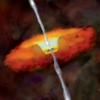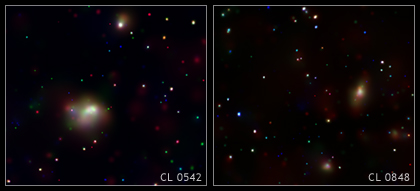Chandra Catches "Piranha" Black Holes
These two galaxy clusters, known as CL 0542-4100 and CL 0848.6+4453, are part of a sample used to count the fraction of galaxies with rapidly growing black holes, also known as active galactic nuclei (AGN). In the Chandra images of these two galaxy clusters, red corresponds to low-energy X-rays, the green to intermediate-energy, and the blue to high-energy X-rays. In each of these two fields, five AGN are found, although one of these may not be a member of the cluster. Many of the AGN are blue sources, as expected, since AGN are known to produce very high-energy X-rays. The diffuse emission is hot gas in the cluster and other point-like sources in the image are nearly all unrelated to the galaxy cluster.
The data show, for the first time, that younger, more distant galaxy clusters contained far more AGN than older, nearby ones. The four galaxy clusters in the distant sample, including the two shown here, are seen when the Universe is only about 58% of its current age. The nearby sample of galaxy clusters, obtained in an earlier study, is seen at about 82% of the Universe's current age. It was found that the more distant clusters contained about 20 times more AGN than the less distant sample. AGN outside clusters are also more common when the Universe is younger, but only by factors of two or three over the same age span.
The reason for this difference is that earlier in the history of the Universe, these galaxies contained a lot more gas for star formation and black hole growth than galaxies in clusters do today. There was so much fuel in young clusters that the piranha-like black holes were able to thrive by growing much earlier than their counterparts in nearby clusters.
|
||||||||||||||||||||||||||||
|
||||||||||||||||||||||||||||





